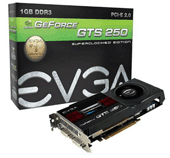Almost 2.5 years later, Crysis still brings many computers to their knees. This is no exception. Worse yet, our test settings are set as high as possible, to keep consistency with this article series. Since we compare the GTS 250, GTX 260, and the GTX 470, we want to make all three an apples to apples comparison. The GTX 260 does quite well and the GTX 470 smokes them both. This is possibly the most important benchmark, since it is based on actual gameplay.
This card, when playing Crysis on Very High settings, tends to hiccup a lot. For instance, standing still in the jungle can yield an average of 15fps. However, as soon as you begin moving or someone shoots at you, the frame rate can suddenly drop down to 2-4. During tense battles, the game can actually become a slideshow. To make this game playable with the GTS 250, you have to limit the settings to Medium with no anti-aliasing.
We ran multiple gameplay benchmarks for both stock and overclocked settings. Check out the averages below. There are two sets of averages below. The first set is with vertical sync turned off, and the second with vertical sync turned on. There lies a wide margin between the framerates.
|
System Settings
|
Crysis Gameplay
|
Overall
|
As you can see, overclocking the GTS 250 isn’t going to change a lot. It only mildly improves game performance with an overall framerate increase of 10%.
If you care more about lab benchmarks, we didn’t neglect you. The FurMark results are next.











